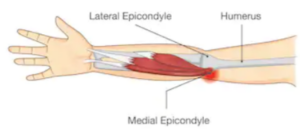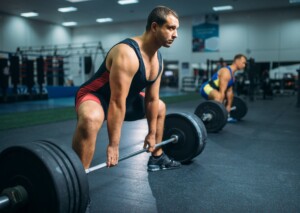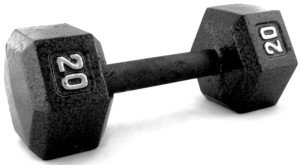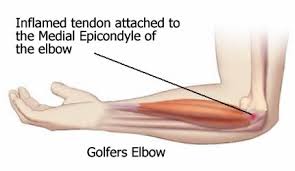
If you have elbow tendonitis, it can greatly interfere with the deadlift.
The type of elbow tendonitis that I had is called medial epichondylitis (golfer’s elbow).
Just a little gripping would aggravate it. My initial therapy (hand grips and very gradual over time increase of resistance on the close-grip hammer-grip pull-down) was working well.
Then I did some very heavy yard work and messed things up. The initial therapy then proved to be worthless.
I then decided to do the two exercises that aggravated the problem the most: farmer walks, and the deadlift.
To my distress, I discovered that a barbell deadlift (which I had been avoiding for a very long time due to this injury) of more than 50 pounds aggravated the tendon. A farmer walk with 15 pound dumbbells aggravated it as well.
You Need a Starting Point
But I decided to make that a starting point. Below is the program I used. It took approximately TEN MONTHS to get my deadlift up to 135 pounds (reps). I consider that a major milestone.
Keep in mind that my inability to initially deadlift more than 40 pounds was due to feeling a tweak in the elbow, rather than lacking the strength.
Same with the farmer walks; carrying the 15 pounders induced an unpleasant feeling in the elbow.
This sensation meant that the tendon was being aggravated.
So do not think in terms of strength. This is rehabilitation of the tendon in your elbow.

Shutterstock/solar22
Getting Your Deadlift Back After an Elbow Tendon Injury

Shutterstock/Nomad_Soul
– At first, six to seven days/week, do farmer walks.
– Deadlift twice a week (Monday and Thursday; Tuesday and Saturday; or Wednesday and Sunday).
– Use a weight for the farmer walks that you can walk around with, literally for five minutes nonstop without making you “feel” anything going on with your elbow. If you can feel anything that you shouldn’t, use a lighter weight.
– Do this three times a day for one week at the same weight.
– Every week, increase the farmer walk weight to the next possible increment. I had three sets of dumbbells at home: 10, 15 and 35 pounds.
Progressive Load of the Weights
Once I was ready to go heavier than 15 pounds, I decided to bring in sets of 3, 5 and 8 pound dumbbells.
I then took four paper grocery bags that had handles. I doubled them up, then placed a 15 pounder and 3 pounder in each (or a 10 and an 8). This way, I could farmer walk with 18 pounds.
Why not just hold the dumbbells without the paper bags?
Because this was being done at home (and daily) where I did not have access to every incrementally-weighted dumbbell at the gym.
After a week I put a 10-, 8- and 3-pounder in each bag, for a 21 pound farmer walk. The doubled bags were sturdy enough still.
I kept increasing over time, so that eventually, I had a 15- and a 10-pounder in each bag. I then put a 15-, 10- and 3-pounder in each bag.
When I was in the gym, I used their incremental dumbbells. However, once I got up to 28 pounds, I decided to par back the farmer walks to three times a week (only at the gym).
This is tedious work: walking around holding dumbbells for five minutes. But this should re-train a compromised elbow tendon to be efficient.
However, the five minute rule can be broken at around 20 pounds. Three minutes will do.

The progression with the farmer walks went a lot slower than with the deadlift.
This is due to the positioning of the hands while carrying the weights; it puts more stress on the tendon.
When I got to 40 pounds with the farmer walks, I still considered myself in rehab mode.
I was strong enough to use 50 pounders, but this would bring out the tweaky feeling in my elbow.
I then built up to farmer walks with a 45 pound plate in each hand (the style with the openings at varying points around the hole).
The plates are easier on the elbow tendon because they don’t require as much of a grip.
More on the Deadlift Rehab
– Do eight reps of the deadlift with 90-120 seconds in between sets, six sets total. This will be very tedious due to the long rests and the ridiculously light weight.

Shutterstock/Vladimir Sukhachev
Do not use a weight that makes you “feel” your elbow tendonitis. Work just below that point. Increase the weight five pounds every two weeks.
If the increase results in “feeling” the tendonitis, return to the previous weight! It took me 10 months with this approach to get from 50 pounds to 135 pounds.
The long rests will protect the tendon from over-work. Do half the sets with an underhand grip and half with an overhand. Do not mix.
– For deadlifts with pre-fixed barbells or an Olympic bar with 25 pound plates or less on it, there’s no need to touch the plates to the floor. Go down as far as you would if you were using 45 pound plates.
– When you get to 35 pound plates, it’s okay, but not necessary, to touch the floor with them.
– If you decide to make contact with the floor, DO NOT BANG THE PLATES! This will force the elbow tendons to absorb some of this!
Instead, gently touch the floor—so gently that you’re the only one who hears it. This includes at the end of each set.
– When you get to 95 pounds, increase the rest to two minutes. The set range can be six to eight.
– You are still increasing by only five pounds every two to three weeks. You’ll be tempted to make bigger increases if the weight you’re using is still very light relative to what you were lifting pre-injury.
The elbow tendonitis is the weakest link and it calls the shots, no matter how much weight your legs, back and shoulders want to lift.
– Don’t assume that once you get to, say, 120 pounds, you’ll be able to increase the incremental gains from five pounds every 2-3 weeks to 10 pounds. Stay with five.
I made a 10 pound jump and “felt it” in my elbow. So I backed down to the five pound increase (and my elbow felt fine).
– Don’t worry what people think when they see you using a light barbell, when you know that they’ve seen you in the past with a much heavier weight! This was difficult for me to digest, but I had to get used to it.
Getting your deadlift back from elbow tendonitis begins with accepting the fact that you will have to be lifting peanuts for many months.


























